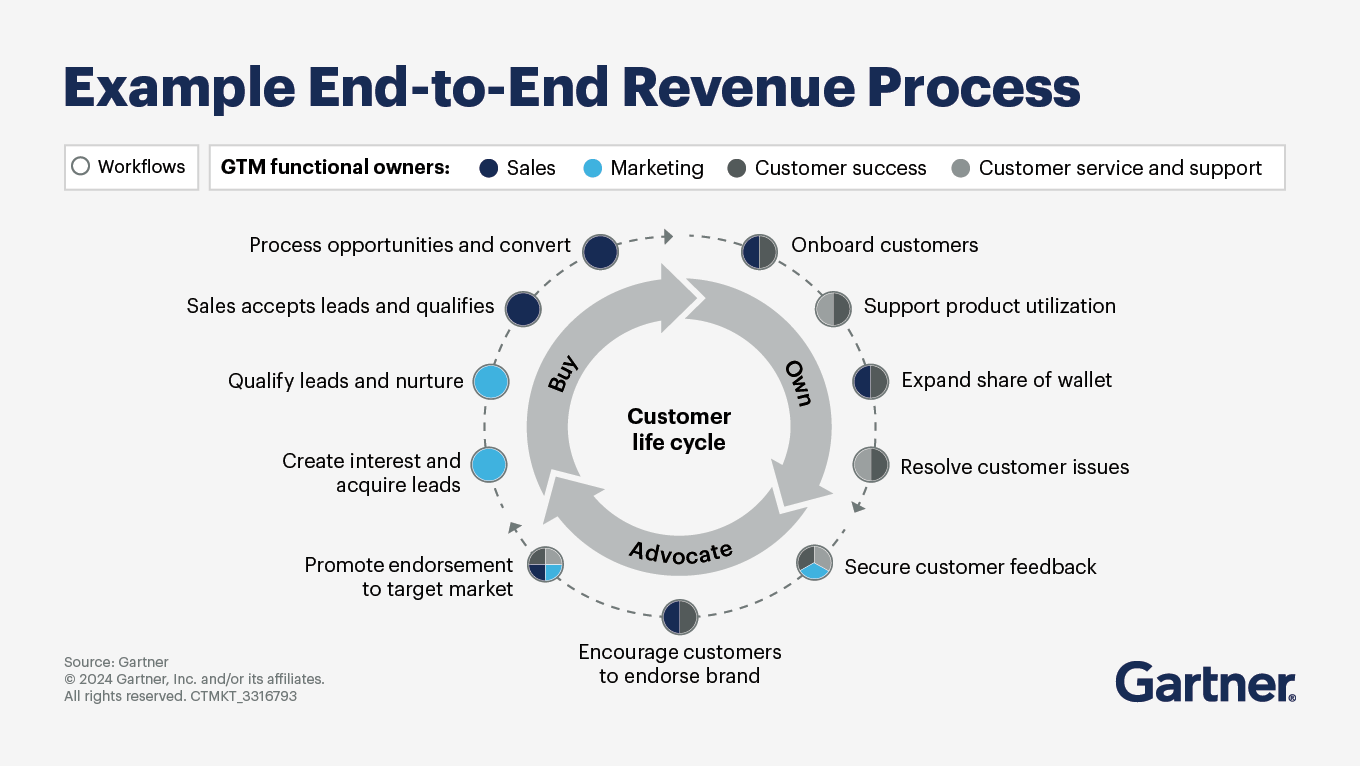Sales operations leaders can use revenue analytics to optimize their go-to-market (GTM) strategies and support revenue growth.
- Gartner client? Log in for personalized search results.
Drive Revenue Growth by Leveraging Analytics in Your Go-to-Market Strategy
By Rachael Buchler | December 9, 2024
Revenue growth challenges sales leaders in a new landscape
In the modern digital landscape, nonlinear customer journeys don’t fit traditional organizational structures — resulting in friction, confusion and lost revenue. On the other hand, companies that align their sales, marketing and support teams across functions are almost three times as likely than those that don’t to exceed their customer acquisition targets.
To create an effective customer journey, businesses must adopt a holistic, data-driven approach to their GTM strategy, led by the sales function. Sales operations leaders, in particular, can help chief sales officers (CSOs) overcome common barriers such as misaligned goals among internal functions, lack of cross-functional visibility and siloed data, through the use of revenue analytics.
3 data-driven strategies for revenue growth
Sales operations leaders can follow the best practices below to strategically deploy analytics and drive revenue growth.
Define the customer life cycle
Sales operations leaders have traditionally focused on the buying phase of the customer journey. Beyond conversions, however, a revenue growth strategy involves retaining and growing the spend of existing customers. This requires a focus on the complete customer life cycle, starting with understanding how commercial activities drive revenue impact across:
The buy cycle, in which sales and marketing work together to convert buyers into customers
The own cycle, in which customers are onboarded and attended so as to improve retention and renewal metrics
The advocate cycle, in which happy customers become advocates for the brand, providing feedback and testimonials in the marketplace
Map the end-to-end revenue process
Defining the end-to-end revenue process provides transparency into the organization’s internal workflows surrounding the customer journey. This helps sales operations leaders understand how the workflows intersect — and who is currently responsible for each.
These workflows should align with the stages of the customer life cycle described above, namely:
“Buy” workflows that emphasize funnel activities to generate leads and convert them into paying customers
“Own” workflows that apply to onboarding new customers and ongoing customer management, and which often involve responsibilities that overlap with customer success and customer service functions
“Advocacy” workflows that may involve a number of different functions and responsibilities, posing challenges that must be surmounted for revenue growth
Select the right use cases for revenue growth
Finally, sales operations leaders must select the appropriate revenue analytics metrics to best assess and report on growth. Gartner recommends connecting these metrics with a specific use case, to understand which interactions and touchpoints have the greatest impact on revenue — and then developing targeted strategies to improve customer acquisition and retention rates.
For example, organizations that want to improve the use case of renewal rates can establish workflow improvements to enhance the customer experience prior to renewal, such as resolving issues and soliciting feedback. To measure the success of these workflows, select metrics like customer satisfaction score (CSAT), customer effort score (CES) and Net Promoter Score (NPS), all of which are correlated with customer renewal. These metrics, when properly distilled, translate into data-driven insights that guide CSOs.
Revenue growth FAQs
What is revenue growth?
Revenue growth is determined by measuring the increase in a company’s sales income over a specific period of time. Tactics for driving revenue growth include acquiring new customers, increasing customer retention rates, expanding into new markets and offering new products.
What workflows are associated with revenue growth?
Businesses may define a number of different workflows that contribute to revenue growth, including:
Customer onboarding to improve customer satisfaction and the likelihood of renewal or retention
Product utilization to demonstrate the value of the product or service and create opportunities for cross- and upselling
Issue resolution to improve customer satisfaction rates
Customer feedback to gather information that helps ensure the product or service’s ongoing value and return on investment
Customer endorsement to strengthen the seller-buyer relationship and increase customer acquisition rates
Attend a Conference
Join Gartner experts and your peers to accelerate growth
Gather alongside your peers in Las Vegas to gain insight on emerging trends, receive one-on-one guidance from a Gartner expert and create a strategy to tackle your priorities head-on.
Gartner CSO & Sales Leader Conference
Las Vegas, NV

Drive stronger performance on your mission-critical priorities.
